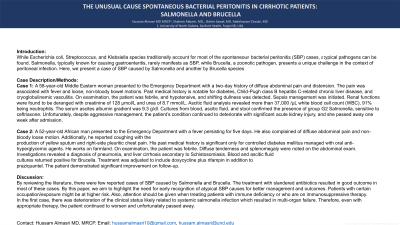Monday Poster Session
Category: Liver
P3053 - The Unusual Cause Spontaneous Bacterial Peritonitis in Cirrhotic Patients: Salmonella and Brucella
Monday, October 28, 2024
10:30 AM - 4:00 PM ET
Location: Exhibit Hall E

Has Audio

Hussam Almasri, MD, MRCP
University of North Dakota
Fargo, ND
Presenting Author(s)
Hussam Almasri, MD, MRCP1, Shahem Abbarh, MD2, Bisher Sawaf, MD3, Abdelnasser Elzouki, MD2
1University of North Dakota, Fargo, ND; 2Hamad Medical Corporation, Doha, Ad Dawhah, Qatar; 3University of Toledo Health Sciences Campus, Toledo, OH
Introduction: While Escherichia coli, Streptococcus, and Klebsiella species traditionally account for the majority of spontaneous bacterial peritonitis (SBP) cases, atypical pathogens can be found. Salmonella, typically known for causing gastroenteritis, rarely manifests as SBP, while Brucella, a zoonotic pathogen, presents a unique challenge in the context of peritoneal infection. Here, we present a case of SBP caused by Salmonella and another by Brucella species
Case Description/Methods: Case 1: A 58-year-old Middle Eastern woman presented to the Emergency Department with a two-day history of diffuse abdominal pain and distension. The pain was associated with fever and loose, non-bloody bowel motions. Past medical history is notable for diabetes, Child-Pugh class B hepatitis C-related chronic liver disease, and cryoglobulinemic vasculitis. On examination, the patient was febrile, and hypotensive, and shifting dullness was detected. Sepsis management was initiated. Renal functions were found to be deranged with creatinine of 128 µmol/L and urea of 8.7 mmol/L. Ascitic fluid analysis revealed more than 37,000 /µL white blood cell count (WBC), 91% being neutrophils. The serum ascites albumin gradient was 9.3 g/dl. Cultures from blood, ascitic fluid, and stool confirmed the presence of group G2 Salmonella, sensitive to ceftriaxone. Unfortunately, despite aggressive management, the patient’s condition continued to deteriorate with significant acute kidney injury, and she passed away one week after admission.
Case 2: A 52-year-old African man presented to the Emergency Department with a fever persisting for five days. He also complained of diffuse abdominal pain and non-bloody loose motion. Additionally, he reported coughing with the production of yellow sputum and right-side pleuritic chest pain. His past medical history is significant only for controlled diabetes mellitus managed with oral anti-hyperglycemic agents. He works on farmland and has direct contact with camels. On examination, the patient was febrile. Diffuse tenderness and splenomegaly were noted on the abdominal exam. Investigations revealed a diagnosis of pneumonia, and liver cirrhosis secondary to Schistosomiasis. Blood and ascitic fluid cultures returned positive for Brucella. Treatment was adjusted to include doxycycline plus rifampin in addition to praziquantel. The patient demonstrated significant improvement on follow-up.
Discussion: We aim to highlight the need for early recognition of atypical SBP causes for better management and outcomes.
Disclosures:
Hussam Almasri, MD, MRCP1, Shahem Abbarh, MD2, Bisher Sawaf, MD3, Abdelnasser Elzouki, MD2. P3053 - The Unusual Cause Spontaneous Bacterial Peritonitis in Cirrhotic Patients: <i>Salmonella</i> and <i>Brucella</i>, ACG 2024 Annual Scientific Meeting Abstracts. Philadelphia, PA: American College of Gastroenterology.
1University of North Dakota, Fargo, ND; 2Hamad Medical Corporation, Doha, Ad Dawhah, Qatar; 3University of Toledo Health Sciences Campus, Toledo, OH
Introduction: While Escherichia coli, Streptococcus, and Klebsiella species traditionally account for the majority of spontaneous bacterial peritonitis (SBP) cases, atypical pathogens can be found. Salmonella, typically known for causing gastroenteritis, rarely manifests as SBP, while Brucella, a zoonotic pathogen, presents a unique challenge in the context of peritoneal infection. Here, we present a case of SBP caused by Salmonella and another by Brucella species
Case Description/Methods: Case 1: A 58-year-old Middle Eastern woman presented to the Emergency Department with a two-day history of diffuse abdominal pain and distension. The pain was associated with fever and loose, non-bloody bowel motions. Past medical history is notable for diabetes, Child-Pugh class B hepatitis C-related chronic liver disease, and cryoglobulinemic vasculitis. On examination, the patient was febrile, and hypotensive, and shifting dullness was detected. Sepsis management was initiated. Renal functions were found to be deranged with creatinine of 128 µmol/L and urea of 8.7 mmol/L. Ascitic fluid analysis revealed more than 37,000 /µL white blood cell count (WBC), 91% being neutrophils. The serum ascites albumin gradient was 9.3 g/dl. Cultures from blood, ascitic fluid, and stool confirmed the presence of group G2 Salmonella, sensitive to ceftriaxone. Unfortunately, despite aggressive management, the patient’s condition continued to deteriorate with significant acute kidney injury, and she passed away one week after admission.
Case 2: A 52-year-old African man presented to the Emergency Department with a fever persisting for five days. He also complained of diffuse abdominal pain and non-bloody loose motion. Additionally, he reported coughing with the production of yellow sputum and right-side pleuritic chest pain. His past medical history is significant only for controlled diabetes mellitus managed with oral anti-hyperglycemic agents. He works on farmland and has direct contact with camels. On examination, the patient was febrile. Diffuse tenderness and splenomegaly were noted on the abdominal exam. Investigations revealed a diagnosis of pneumonia, and liver cirrhosis secondary to Schistosomiasis. Blood and ascitic fluid cultures returned positive for Brucella. Treatment was adjusted to include doxycycline plus rifampin in addition to praziquantel. The patient demonstrated significant improvement on follow-up.
Discussion: We aim to highlight the need for early recognition of atypical SBP causes for better management and outcomes.
Disclosures:
Hussam Almasri indicated no relevant financial relationships.
Shahem Abbarh indicated no relevant financial relationships.
Bisher Sawaf indicated no relevant financial relationships.
Abdelnasser Elzouki indicated no relevant financial relationships.
Hussam Almasri, MD, MRCP1, Shahem Abbarh, MD2, Bisher Sawaf, MD3, Abdelnasser Elzouki, MD2. P3053 - The Unusual Cause Spontaneous Bacterial Peritonitis in Cirrhotic Patients: <i>Salmonella</i> and <i>Brucella</i>, ACG 2024 Annual Scientific Meeting Abstracts. Philadelphia, PA: American College of Gastroenterology.
